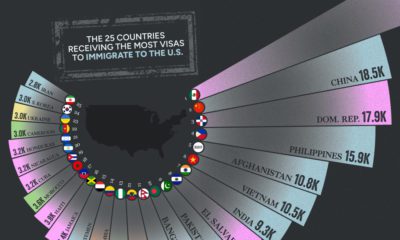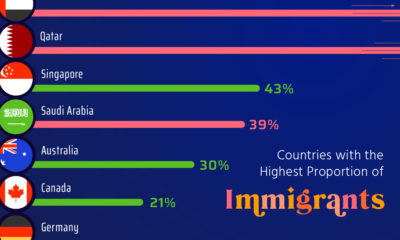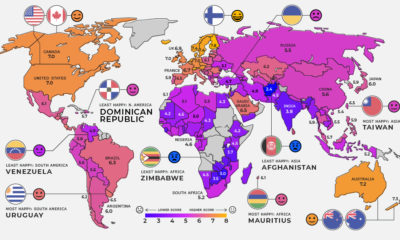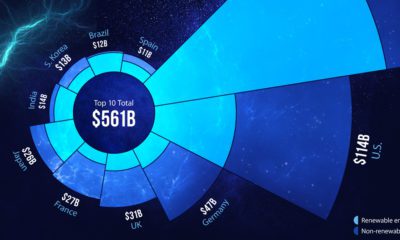However, these characteristics are not static—and drastic demographic changes are starting to create powerful ripple effects in the 21st-century economy.
The Impact of Demographics and Social Changes
Today’s infographic from BlackRock delves into the significant impact that demographics and human rights movements have on global markets. Of the five megatrends explored in this series, demographics are predicted to have the farthest-reaching impact.
What are Demographics?
Demographics are the characteristics of populations that change over time. These include:
Age Gender Race Birth and death rates Education levels Income levels Average family size
As a result, major demographic trends offer both unique challenges and opportunities for businesses, societies, and investors.
The Biggest Shifts
What are the biggest shifts in demographics that the world faces today?
1. Aging Population
The global population is aging rapidly─as fertility rates decline worldwide, those in the 65 years and older age bracket are steadily increasing in numbers.
2. Future Workforce
As the population continues to age, fewer people are available to sustain the working population. For the first time in recorded history, the number of people in developed nations between 20 to 64 years old is expected to shrink in 2020.
3. Immigration Increase
Immigration has been steadily increasing since the turn of the 21st century. Primary migration factors range from the serious (political turmoil) to the hopeful (better job offers). In particular, areas such as Asia and Europe see much higher movement than others, causing a strain on resources in those regions.
4. Consumer Spending
A steadily aging population is slowly shifting the purchasing power to older households. In Japan, for example, half of all current household spending comes from people over 60, compared with 13% of spending from people under 40.
How Does Social Change Play a Part?
Demographics are the characteristics of people that change over time, whereas social change is the evolution of people’s behaviours or cultural norms over time. Strong social change movements have often been influenced by demographic changes, including:
Ending poverty and hunger Expanding healthcare in developing nations Reforming education quality and accessibility Championing gender and racial equality
Examples of major human rights movements include creating stronger environmental policies and securing women’s right to vote.
Opportunities for Investors
These changes pose some exciting opportunities for investors, both now and in the near future.
Healthcare
Global healthcare spending is predicted to grow from US$7.7 trillion in 2017 to over US$10 trillion in 2022. To meet the demands of age-related illnesses, companies will need solutions that offer quality care at much lower costs—for patients and an overburdened healthcare system.
Changing Workforce
With a declining working population, adapting a workforce’s skill set may be the key to keeping economies afloat. As automation becomes commonplace, workers will need to develop more advanced skills to stay competitive. Newer economies will need to ensure that automation supports a shrinking workforce, without restricting job and wage growth.
Education Reform
By 2100, over 50% of the world will be living in either India, China, or Africa.
—Shannon May, CoFounder of Bridge International Academies
In the future, education and training in these growing regions will be based on skills relevant to the modern workforce and shifting global demographics.
Consumer Behaviour
Spending power will continue to migrate to older populations. Global consumer spending from those over 60 years is predicted to nearly double, from US$8 trillion in 2010 to a whopping US$15 trillion in 2020.
Investing Megatrends
Demographics and social changes are the undercurrents of many economic, cultural, and business decisions. They underpin all other megatrends and will significantly influence how the world evolves. As demographics shift over time, we will see the priorities of economies shift as well─and these changes will continue to offer new opportunities for investors to make an impact for the future of a global society. on Even while political regimes across these countries have changed over time, they’ve largely followed a few different types of governance. Today, every country can ultimately be classified into just nine broad forms of government systems. This map by Truman Du uses information from Wikipedia to map the government systems that rule the world today.
Countries By Type of Government
It’s important to note that this map charts government systems according to each country’s legal framework. Many countries have constitutions stating their de jure or legally recognized system of government, but their de facto or realized form of governance may be quite different. Here is a list of the stated government system of UN member states and observers as of January 2023: Let’s take a closer look at some of these systems.
Monarchies
Brought back into the spotlight after the death of Queen Elizabeth II of England in September 2022, this form of government has a single ruler. They carry titles from king and queen to sultan or emperor, and their government systems can be further divided into three modern types: constitutional, semi-constitutional, and absolute. A constitutional monarchy sees the monarch act as head of state within the parameters of a constitution, giving them little to no real power. For example, King Charles III is the head of 15 Commonwealth nations including Canada and Australia. However, each has their own head of government. On the other hand, a semi-constitutional monarchy lets the monarch or ruling royal family retain substantial political powers, as is the case in Jordan and Morocco. However, their monarchs still rule the country according to a democratic constitution and in concert with other institutions. Finally, an absolute monarchy is most like the monarchies of old, where the ruler has full power over governance, with modern examples including Saudi Arabia and Vatican City.
Republics
Unlike monarchies, the people hold the power in a republic government system, directly electing representatives to form government. Again, there are multiple types of modern republic governments: presidential, semi-presidential, and parliamentary. The presidential republic could be considered a direct progression from monarchies. This system has a strong and independent chief executive with extensive powers when it comes to domestic affairs and foreign policy. An example of this is the United States, where the President is both the head of state and the head of government. In a semi-presidential republic, the president is the head of state and has some executive powers that are independent of the legislature. However, the prime minister (or chancellor or equivalent title) is the head of government, responsible to the legislature along with the cabinet. Russia is a classic example of this type of government. The last type of republic system is parliamentary. In this system, the president is a figurehead, while the head of government holds real power and is validated by and accountable to the parliament. This type of system can be seen in Germany, Italy, and India and is akin to constitutional monarchies. It’s also important to point out that some parliamentary republic systems operate slightly differently. For example in South Africa, the president is both the head of state and government, but is elected directly by the legislature. This leaves them (and their ministries) potentially subject to parliamentary confidence.
One-Party State
Many of the systems above involve multiple political parties vying to rule and govern their respective countries. In a one-party state, also called a single-party state or single-party system, only one political party has the right to form government. All other political parties are either outlawed or only allowed limited participation in elections. In this system, a country’s head of state and head of government can be executive or ceremonial but political power is constitutionally linked to a single political movement. China is the most well-known example of this government system, with the General Secretary of the Communist Party of China ruling as the de facto leader since 1989.
Provisional
The final form of government is a provisional government formed as an interim or transitional government. In this system, an emergency governmental body is created to manage political transitions after the collapse of a government, or when a new state is formed. Often these evolve into fully constitutionalized systems, but sometimes they hold power for longer than expected. Some examples of countries that are considered provisional include Libya, Burkina Faso, and Chad.














